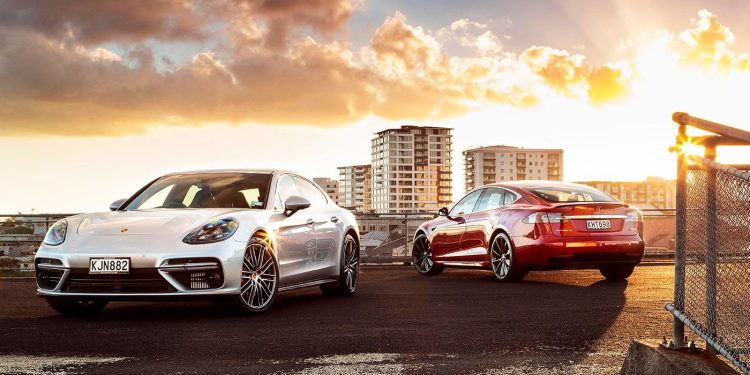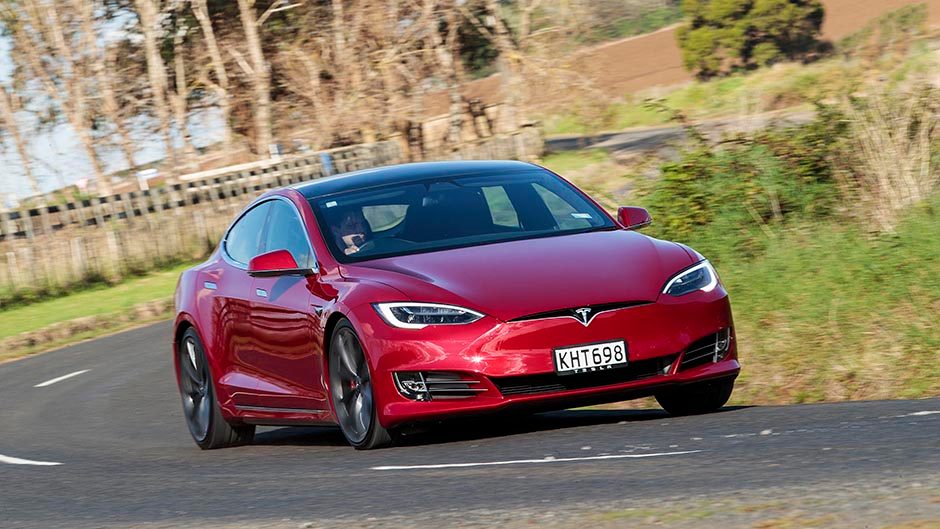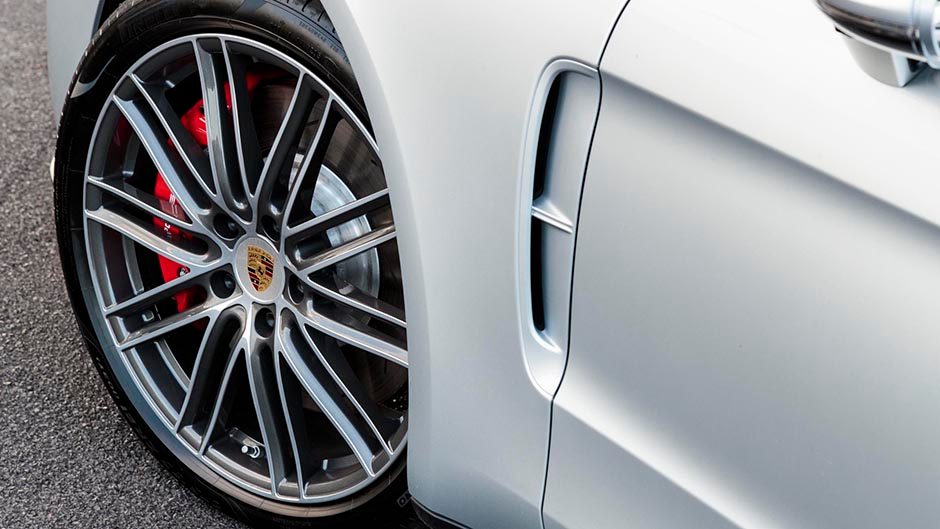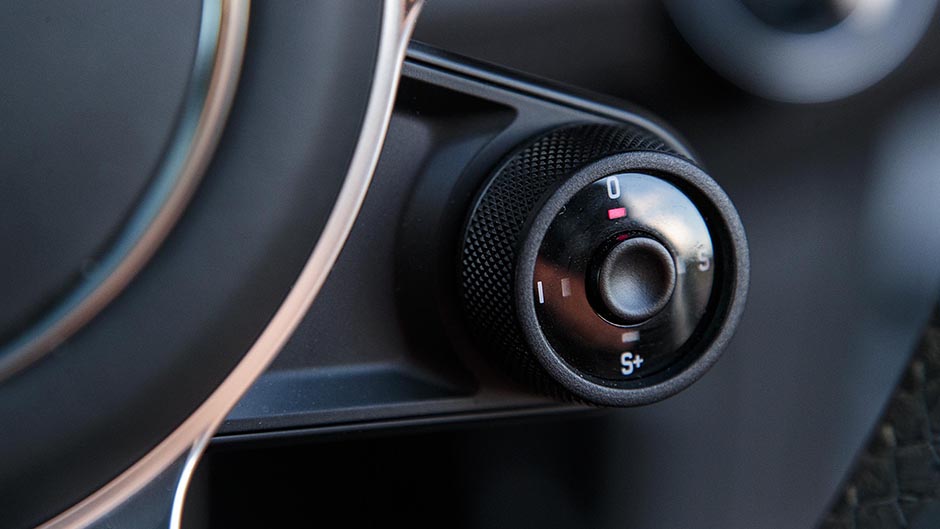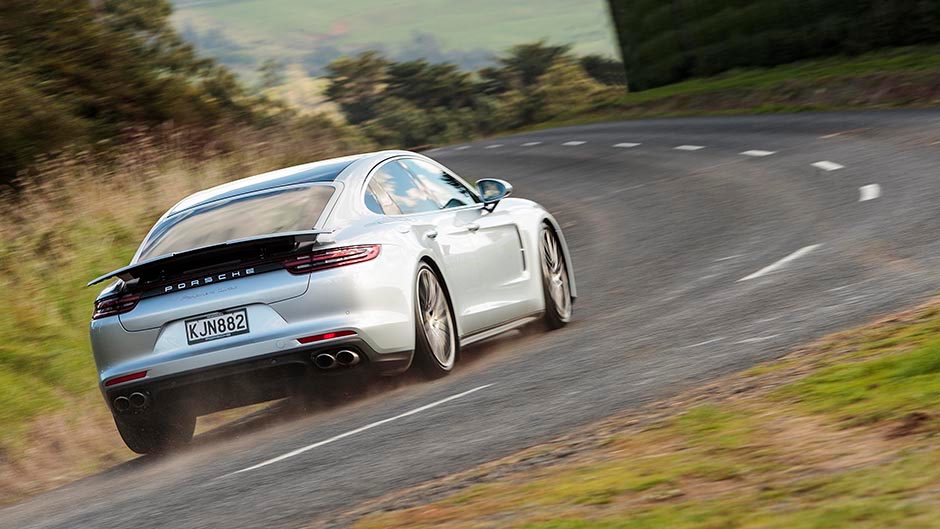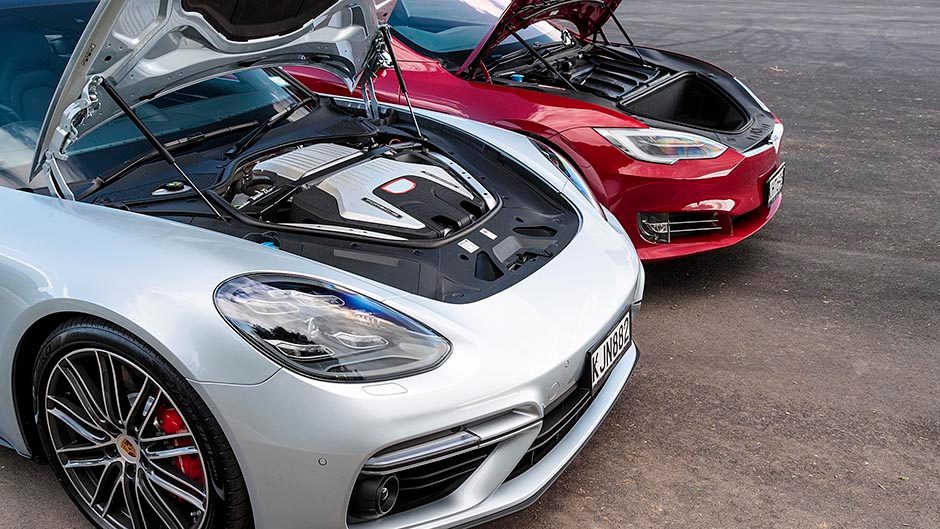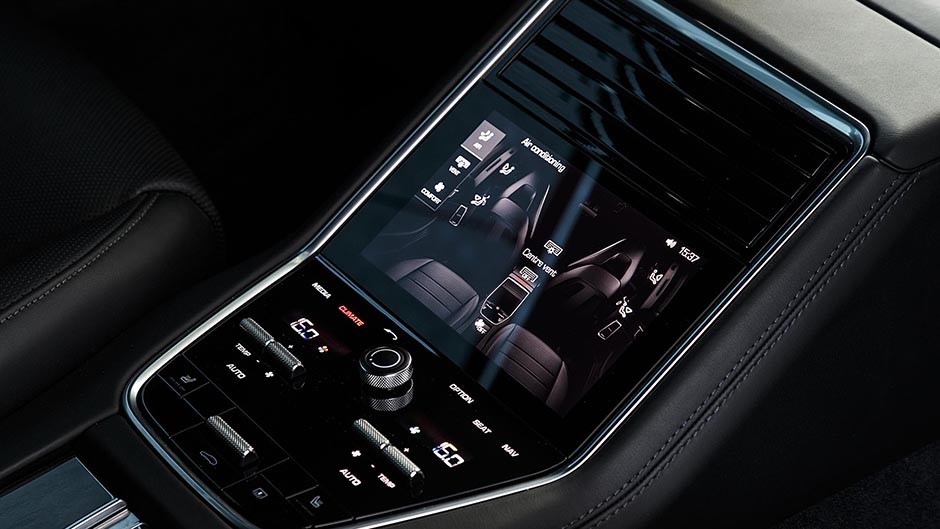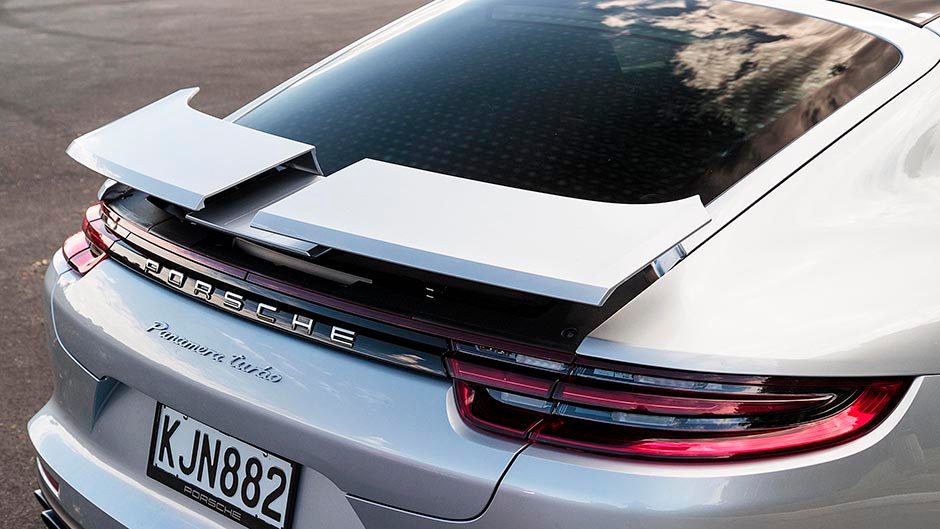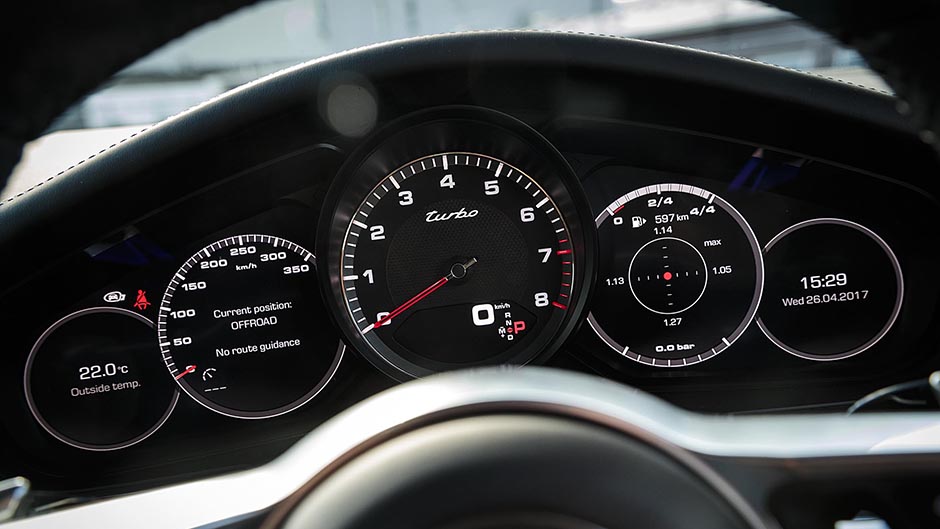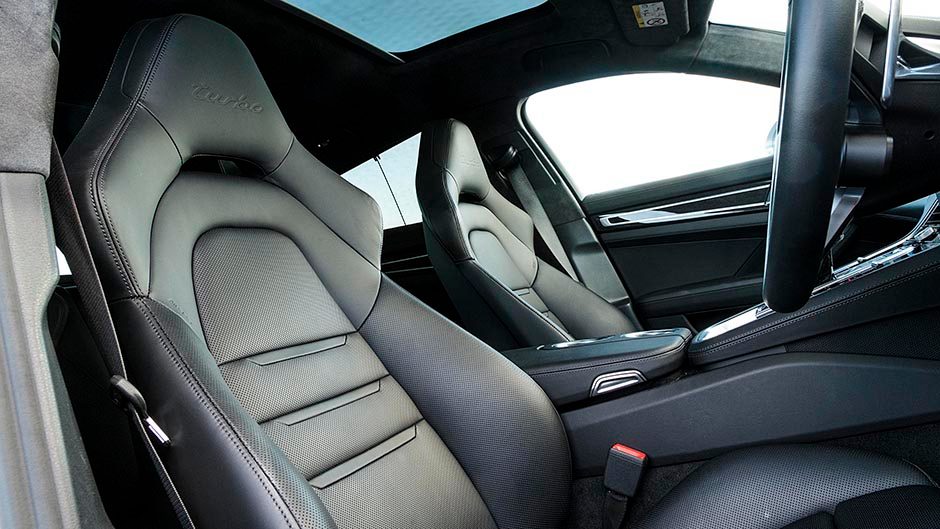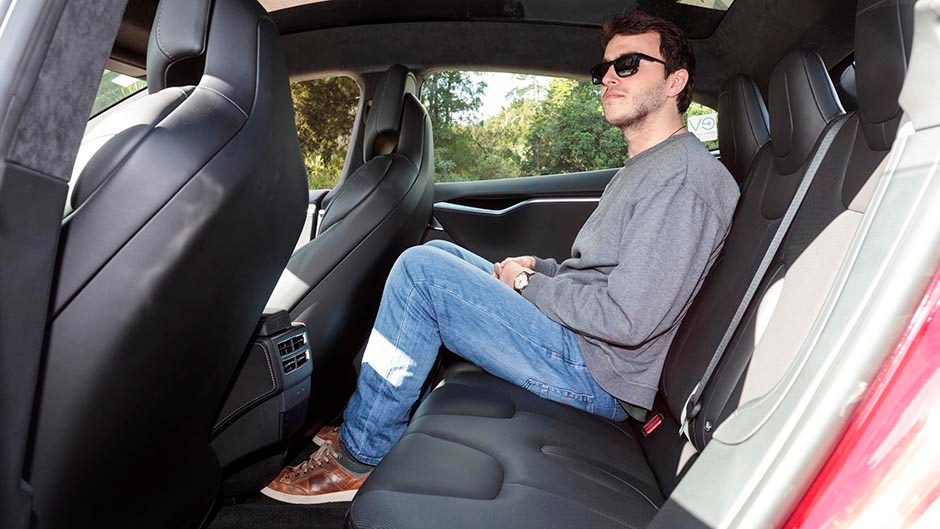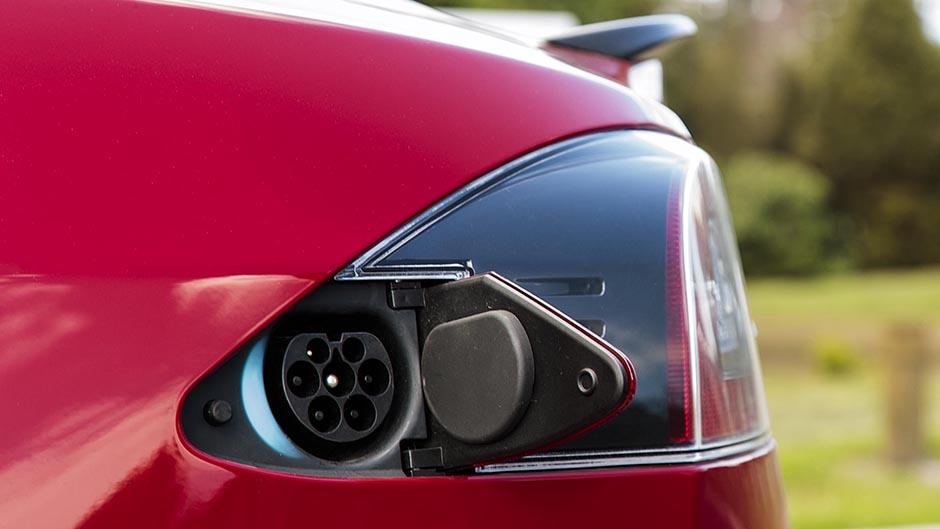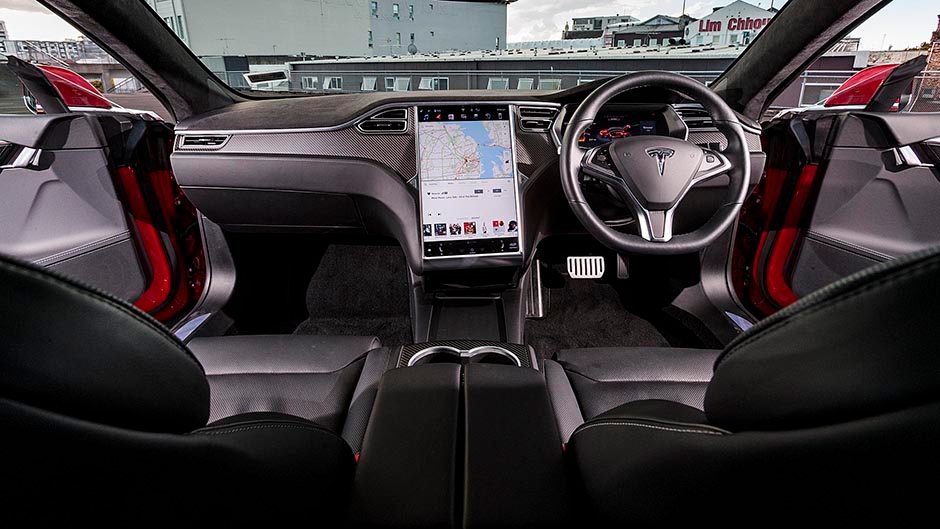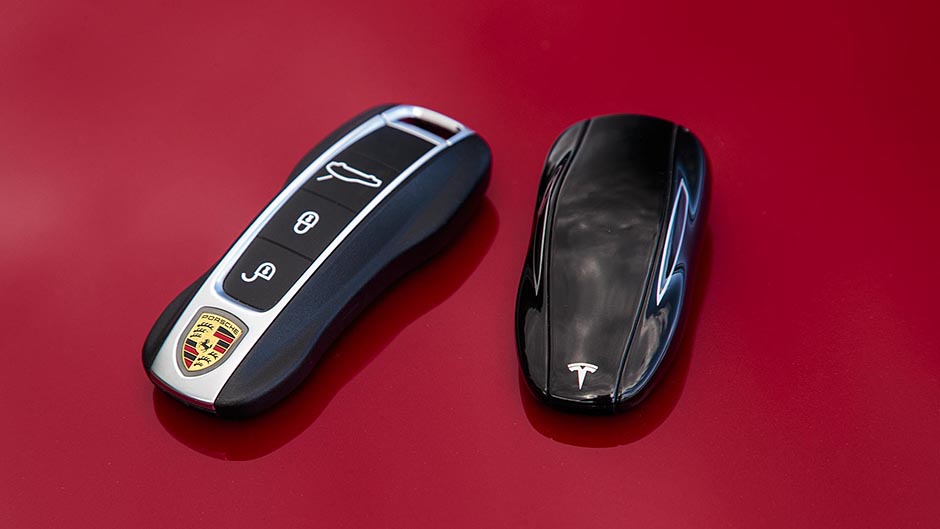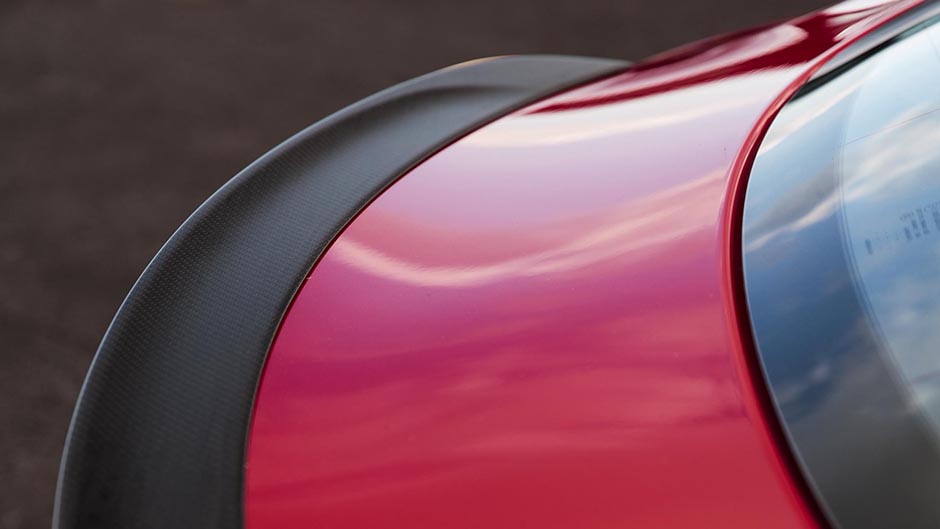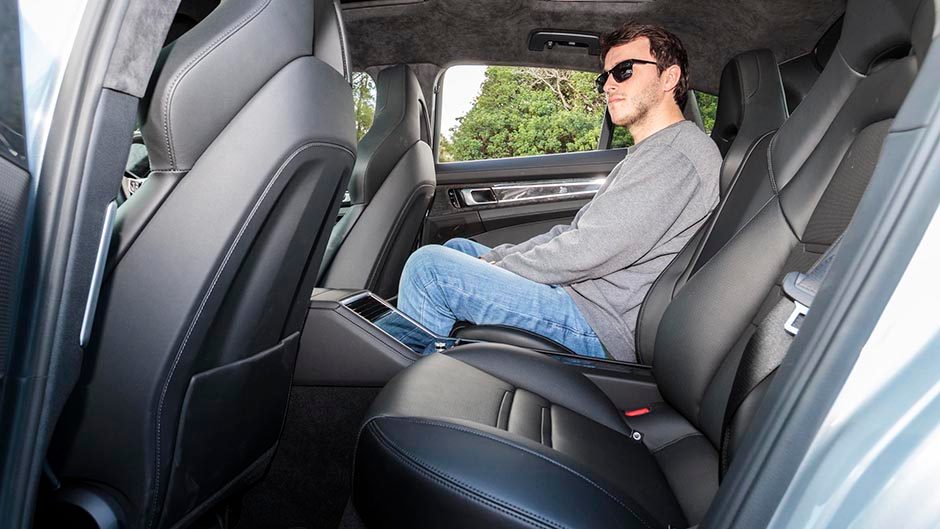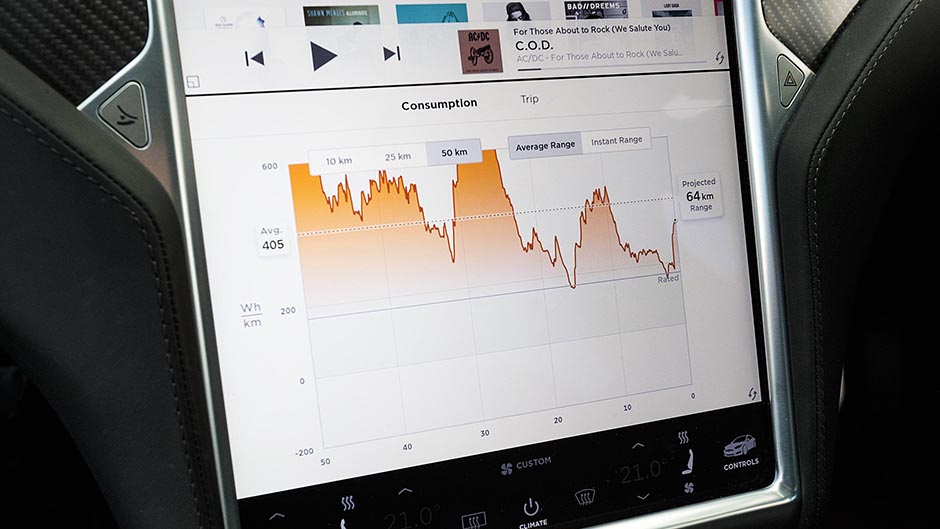2017 Tesla Model S P100D vs Porsche Panamera Turbo comparison
Words: Kyle Cassidy | Photos: Tom Gasnier
There’s virtual hysteria surrounding Tesla’s arrival here, and the Model S P100d is the one everyone is talking about. We measure its worth against the new Porsche Panamera Turbo. Let the sparks fly!
Just what is the world’s best four-door? There are a few contenders but the hottest right now seems to be Tesla’s Model S P100D courtesy of its outrageous acceleration feats, which has most believing it to be the world’s fastest production car. But with a top speed of 250km/h, that can’t be right. We think what they mean is fastest accelerating production car, with a 0-100km/h time of 2.7sec. And it’s electric. But you already knew that.
Should you believe the hype? It’s amazing in some regards yet below par in others, especially when compared with another saloon-like GT, the new Porsche Panamera. So what gives? And strictly speaking, we know they are not four-doors, both with hatchback tailgates, but you get our drift.
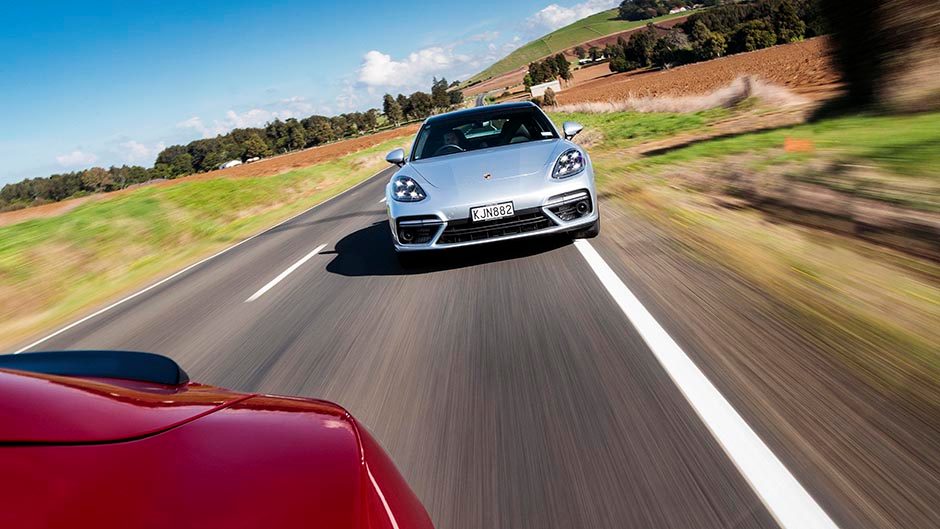
The Panamera
The second-generation Panamera is slightly bigger all around, and no, your eyes aren’t deceiving you, it’s much better looking. We’ve always appreciated the dynamic nature of the big Porsche but now with styling to match, it’s genuinely desirable. And with a $346,300 price tag, this Turbo model is a definite dream machine. With options, this tester was $378,490.
Improving the proportions is a wheelbase increased by 30mm, the front wheels pushed forward, and the roofline dropped at the rear. It sits on the new MSB platform which Porsche developed for the VW group, aluminium used for the front section of the chassis and for most of the panels. There’s more tech too, night vision optional for instance while matrix LED headlights are standard, as is most of the active safety gear.
For the Turbo model there is a new 4.0-litre twin-turbo V8, 404kW the headline number, and 770Nm of rear-end-squatting torque from 1960 to 4500rpm. With the optional Sport Chrono pack 3.6sec to 100km/h is the claim, as is 9.4L/100km on average with cylinder deactivation a feature. The new eight-gear twin-clutch helps with its wider spread of ratios. Lesser models get a 2.9-litre V6 TT with 324kW and 550Nm, and the new V8 diesel model is expected to be popular here with 310kW and 850Nm. There are two hybrids, including the Turbo S E-hybrid with 500kW, 850Nm and a $422k price tag.
Variable all-wheel drive again features, while new air springs gain a three-chamber set-up for increased air capacity, giving both a softer Comfort mode and a faster-reacting Sport mode. New alloy wishbones live front and rear, subframes rigidly mounted for handling precision, yet there are also some serious sounding hydraulic bushings to improve comfort further. The Panamera needs to do it all, remember. Dynamic enhancing options include active roll bars, a torque vectoring sports diff, and rear axle steering.
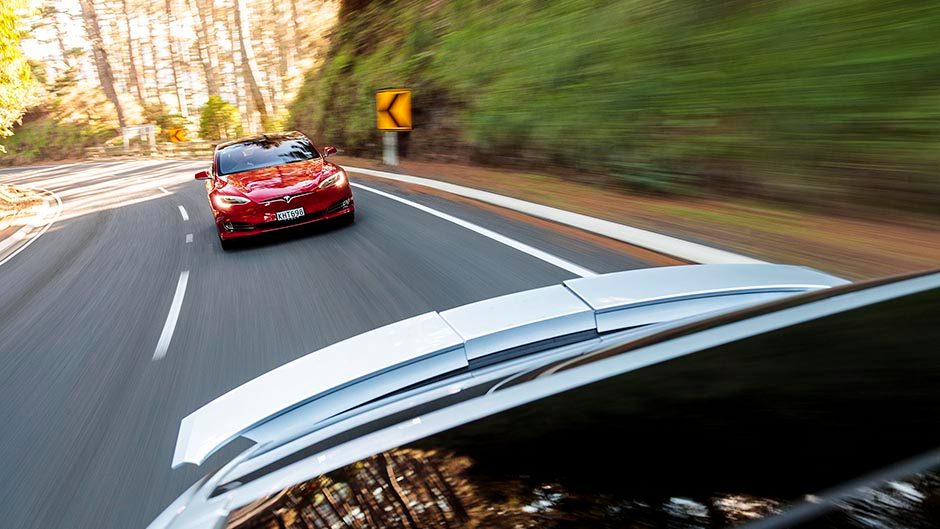
The P100D
The Tesla alpha dog is the P100D. Figures include a 100kWh battery (a Leaf’s is between 24 and 30kwh depending on the model), a 613km range, 250km/h top speed, and 100km/h in 2.7sec. The battery and powertrain are covered by an eight-year, unlimited kay warranty. Its all-alloy chassis houses the battery pack centrally under the floor and on D (for dual) models, there is a motor at each axle, the single-speed transaxle and inverter housed at the rear. Suspension is via air as well. The Dual motor set-up means it is AWD, the front motor chipping in when needed. The Tesla website lists the P100D at $236,100 and the brand is famous for its zero discount policy. The tester wore $30k worth of options with bigger wheels, special paint, glass roof, premium interior upgrades, a banging sound system and a charger upgrade to boot. Tesla’s infamous autopilot system was disabled on the test car, and is listed as an $8300 option, with full self-drive function a further $5000, though this is subject to a raft of operating conditions.
What about that luxury feeling?
With its space efficient EV powertrain, the Model S has a roomy cabin, particularly up front but there’s a decidedly mass market feel to some aspects of the interior while there are some iffy panel gaps and ill-fitting trim pieces on the exterior. But there are some interesting bits too, the dash design and door trims, and the leather work is sound. Merc switchgear is present (Daimler was an early investor in Tesla) and distracting your attention away from the not-so-great bits is the incredible central screen, which can’t be faulted for its operation, resolution and response. And its connectedness, Tesla models coming with an internet connection for three years (thereafter, you pay).
The Panamera has a new infotainment system with a well integrated wide screen and its configurable set up, while the centre console, once dominated by buttons, now features touch sensitive surfaces which are both a visual and tactile treat. The instrument panel is configurable too, with a pair of LCD screens flanking an analogue tacho to remind us of Porsche’s long and storied motor racing pedigree. Well, that’s what it says to me. Only the noisy air con annoyed, and lack of storage compared with the Tesla but ensconced in the cabin of the Panamera it’s clear this is in another league of luxury.
It’s business class in the back too with two separate seats, your own control panel for things and other than a cramped footwell there’s enough space. The rear of the Tesla is more spacious with room for three, but is otherwise unremarkable. Both have hatchback-style tailgates, and there’s more space in the Tesla with underfloor storage as well, but again the finishing doesn’t convey the pricetag.
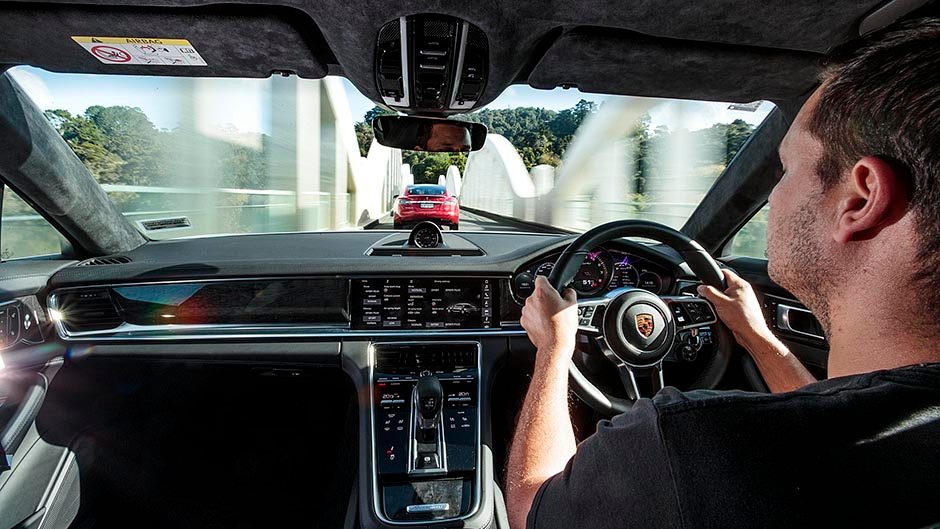
Doing it easy
Approach the Model S and the door handles pop out, well, most of the time, and to start ‘er up, you simply pull the lever into D and prod the go pedal. It’s a stellar commuter with an ultra-smooth power delivery and it’s hushed on the move; even on coarse chip it’s quiet. The steering is light, the air sprung ride supple and while there are only two settings for the brake regeneration, on and off, it’s set up well for town use. As a town car that will also get you between cities, it does a fine job. You’ll need the home wall charger as the big battery takes forever to charge on a 10A wall plug, every hour plugged in only netting you around 15km of range.
The Panamera fires into life with a roar, reminding nicely of its conventional powertrain. There’s plentiful adjustment with the Panamera, drive modes sorted easily with the wheel-mounted switch. Given it’s performance bent, we preferred driving the Panamera in Sport mode for more immediate responses, the experience not interrupted by the hyperactive stop/start or overly economical transmission protocols. Set to Comfort the ride is pleasant too, and the steering is easy, particularly with the rear wheels helping. So the Panamera can pamper but it can also boogie.
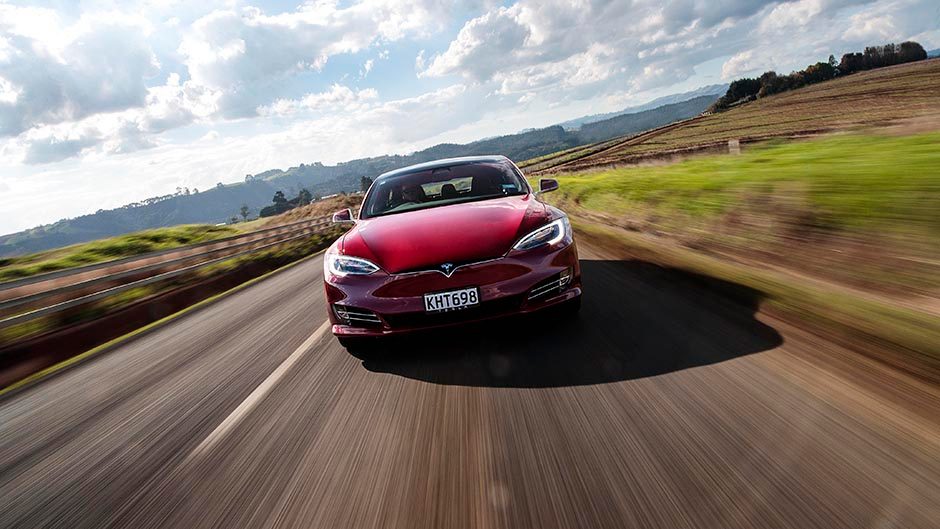
Going hard
Drive the Model S the way the Panamera begs for it, and it’s nowhere near as convincing. It is power delivery that is the Tesla’s forte; it’s simply unparalleled. You hit the throttle and it’s gone, no waiting around, it just surges forward. We strained our neck muscles overdosing on the ludicrous acceleration mode. Though we couldn’t wait around for 30 minutes for the battery to warm to peak performance, the P100D still managed 0-100km/h in 3.1sec (apparently these P100D’s give best performance when they are fully charged and warmed to optimum temperature) on the same strip of coarse chip road that the Panamera Turbo managed 3.5sec. So it’s genuinely fast, it’s 80-120km/h time of 1.9sec seeing off the Turbo’s 2.1sec, and just about everything else we’ve ever tested, exotic supercars the exception.
And what about the bends?
The P100D’s steering has three modes, Sport delivering more weight and while it’s reasonably direct, it lacks for connection. In something this quick, you need to know intimately what those front wheels are up to, but that’s kind of lacking here. Riding in low mode, the suspension delivers more body control without transferring too many bumps and, given the position of the battery pack, it’s well balanced. With lots of rubber, there’s grip enough but you’re just not too sure when it’s about to end. The brakes are powerful but like the helm, lack tactility.
Like any performance model, once you start using its full potential it starts sucking its energy source. We sent the energy usage graph off the scale, and the P100D’s indicated 510km range quickly shrunk to 130km after 98km of driving. And 25km of those were motorway miles. All was going well until about half way around one of our regular drive loops when it lost its killer surge as it retreated into some form of safe mode, indicating the batteries were getting too warm.
The only way that the Panamera will surrender is when it’s tank is dry. It’s an utterly superior driver’s car. While it’s fast, it’s a different type of quick. The response of the Tesla is unbeatable. You punch the gas in the Porsche and the surge isn’t as forceful, especially if there’s a transmission delay as it sorts the gears. And we are talking about a very slick twin-clutch unit. But the Porsche’s steering is bliss, more finessed, more connected, locking you onto your line and allowing you to work the front end hard with no need for constant mid-corner adjustments like the Tesla demands. The P100D has bulk traction, but with Porsche’s AWD system there’s no power-on understeer to contend with, this car assisted ably by the optional rear steer, which goes about its trickery invisibly. A car this big shouldn’t really be as nimble in the tight stuff while remaining rock steady in longer sweepers. With dampers set to Sport there is enough control with compliancy to sort the road, while the powertrain in Sport Plus mode is amped for action. The engine is a monster with real pull from 2000rpm and power flowing round past 6000rpm. And there’s noise, glorious noise, the sports exhaust lets you know its a V8 working away. The Panamera is noisier with more tyre roar, and while fuel use wasn’t too horrendous, up to 16.8L/100km at one point, it was still 16.8 more than the Model S.
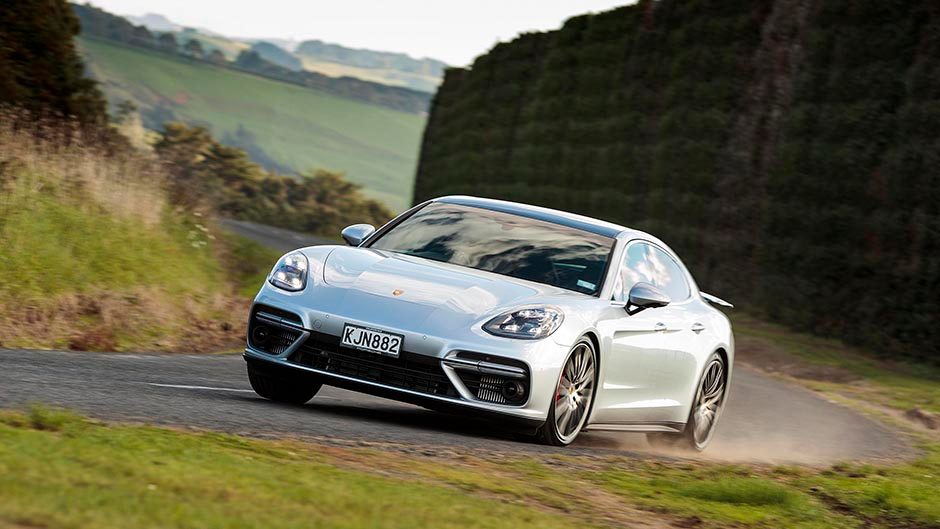
The ultimate four door then?
It’s not the Model S P100D. The powertrain is phenomenal yes, but dynamic aspects of the Model S let it down. That it threw in the towel during the drive was disappointing for the ‘fastest production car in the world’. The cabin quality needs to be improved too. The Panamera Turbo is the superior all round performer, and a better luxury car. But the Tesla format is the future, and its next offering can only be better, remembering that the Models S is already five years old. That the Turbo is not the top Panamera, but rather the 500kW turbo S E-Hybrid, shows the direction Porsche is heading too. The third generation of Panamera will be all hybrid and EV, so the rematch in 2025 will be interesting.
| Model | Tesla Model S P100D | Price | $236,100 |
| Engine | dual AC electric motors | Drivetrain | e-AWD |
| Fuel Use | 0L/100km | C02 Output | 0g/km |
| 0-100km/h | 3.10sec | Weight | 2278kg |
| Model | Porsche Panamera Turbo | Price | $346,300 |
| Engine | 3996cc, V8, T/DI, 404kW/770Nm | Drivetrain | 7-speed twin-clutch, all-wheel drive |
| Fuel Use | 9.4L/100km | C02 Output | 214g/km |
| 0-100km/h | 3.49sec | Weight | 2057kg |


